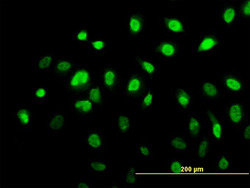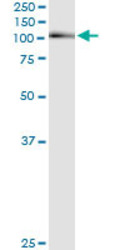Antibody data
- Antibody Data
- Antigen structure
- References [4]
- Comments [0]
- Validations
- Western blot [1]
- ELISA [1]
- Immunocytochemistry [1]
- Immunoprecipitation [1]
Submit
Validation data
Reference
Comment
Report error
- Product number
- H00000196-M02 - Provider product page

- Provider
- Abnova Corporation
- Proper citation
- Abnova Corporation Cat#H00000196-M02, RRID:AB_605915
- Product name
- AHR monoclonal antibody (M02), clone 3B12
- Antibody type
- Monoclonal
- Description
- Mouse monoclonal antibody raised against a partial recombinant AHR.
- Antigen sequence
MGSFEPSPYPTTSSLEDFVTCLQLPENQKHGLNPQ
SAIITPQTCYAGAVSMYQCQPEPQHTHVGQMQYNP
VLPGQQAFLNKFQNGVLNETYPAELNNINN- Isotype
- IgG
- Antibody clone number
- 3B12
- Storage
- Store at -20°C or lower. Aliquot to avoid repeated freezing and thawing.
Submitted references Cross-talk between aryl hydrocarbon receptor and the inflammatory response: a role for nuclear factor-κB.
Gender matters: estrogen receptor alpha (ERα) and histone deacetylase (HDAC) 1 and 2 control the gender-specific transcriptional regulation of human uridine diphosphate glucuronosyltransferases genes (UGT1A).
Malassezia-derived indoles activate the aryl hydrocarbon receptor and inhibit Toll-like receptor-induced maturation in monocyte-derived dendritic cells.
Diminished carcinogen detoxification is a novel mechanism for hypoxia-inducible factor 1-mediated genetic instability.
Vogel CF, Khan EM, Leung PS, Gershwin ME, Chang WL, Wu D, Haarmann-Stemmann T, Hoffmann A, Denison MS
The Journal of biological chemistry 2014 Jan 17;289(3):1866-75
The Journal of biological chemistry 2014 Jan 17;289(3):1866-75
Gender matters: estrogen receptor alpha (ERα) and histone deacetylase (HDAC) 1 and 2 control the gender-specific transcriptional regulation of human uridine diphosphate glucuronosyltransferases genes (UGT1A).
Kalthoff S, Winkler A, Freiberg N, Manns MP, Strassburg CP
Journal of hepatology 2013 Oct;59(4):797-804
Journal of hepatology 2013 Oct;59(4):797-804
Malassezia-derived indoles activate the aryl hydrocarbon receptor and inhibit Toll-like receptor-induced maturation in monocyte-derived dendritic cells.
Vlachos C, Schulte BM, Magiatis P, Adema GJ, Gaitanis G
The British journal of dermatology 2012 Sep;167(3):496-505
The British journal of dermatology 2012 Sep;167(3):496-505
Diminished carcinogen detoxification is a novel mechanism for hypoxia-inducible factor 1-mediated genetic instability.
Schults MA, Timmermans L, Godschalk RW, Theys J, Wouters BG, van Schooten FJ, Chiu RK
The Journal of biological chemistry 2010 May 7;285(19):14558-64
The Journal of biological chemistry 2010 May 7;285(19):14558-64
No comments: Submit comment
Supportive validation
- Submitted by
- Abnova Corporation (provider)
- Main image

- Experimental details
- Western Blot analysis of AHR expression in transfected 293T cell line by AHR monoclonal antibody (M02), clone 3B12.Lane 1: AHR transfected lysate(96.147 KDa).Lane 2: Non-transfected lysate.
Supportive validation
- Submitted by
- Abnova Corporation (provider)
- Main image

- Experimental details
- Detection limit for recombinant GST tagged AHR is approximately 0.03ng/ml as a capture antibody.
- Validation comment
- Sandwich ELISA (Recombinant protein)
- Protocol
- Protocol
Supportive validation
- Submitted by
- Abnova Corporation (provider)
- Main image

- Experimental details
- Immunofluorescence of monoclonal antibody to AHR on HeLa cell. [antibody concentration 10 ug/ml]
- Validation comment
- Immunofluorescence
- Protocol
- Protocol
Supportive validation
- Submitted by
- Abnova Corporation (provider)
- Main image

- Experimental details
- Immunoprecipitation of AHR transfected lysate using anti-AHR monoclonal antibody and Protein A Magnetic Bead (U0007), and immunoblotted with AHR MaxPab rabbit polyclonal antibody.
- Validation comment
- Immunoprecipitation
- Protocol
- Protocol
 Explore
Explore Validate
Validate Learn
Learn Western blot
Western blot